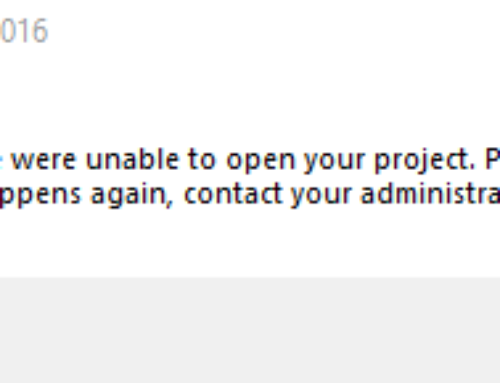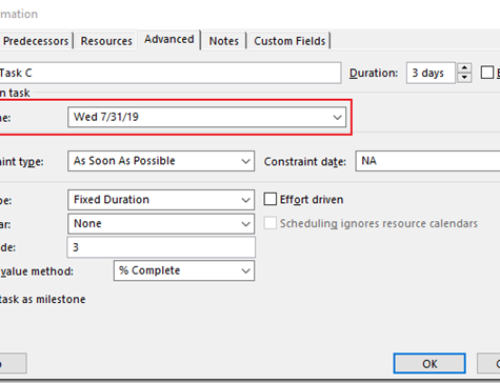Microsoft Project Server 2010 and 2013 December 2014 CU Announcement
Microsoft Project Server 2010 and 2013 December 2014 CU Announcement
Thank you Brian for your latest blog.
For those that want the cheat sheet on the Project and Project Server related fixes, here are my personal takeaways. Remember to ALWAYS test and validate any CU or SP in a DEV environment prior to installing in PROD.
- There will be no January CU
- For Project Server 2013: It is a good practice to load SP1, then the December 2014 CU and then run the configuration wizard (if you didn’t already load the April 2013 through June 2014 CU).
- Project Server and SharePoint Server 2013: There are several and we have seen almost all of these errors/bugs – so you may want to check out them all, but here are the top offends in my opinion: http://support.microsoft.com/kb/2910944
- When you use a template to create a project in PWA, and the template
contains a null task, the project cannot be displayed in Project views, and you
may receive the following error message:
- View Failure The view failed to load.
Press OK to reload this view with
the default settings. Press Cancel to select another view.
- Additionally, the CPU usage may reach 100 percent.
Note A null
task is a blank row between rows. - Assume that you add actual work to a task in a timesheet and then save it. Later, the project manager publishes another task, and the new task appears on the same timesheet. You add actual work to the new task and you submit the timesheet for approval. In this situation, the timesheet line for approval of the new task is not displayed in the Approval center.
- Assume that you create a risk or an issue for a project in PWA, then you save it. When you visit a Project Centerview that includes Active Risks and Active Issues fields, the values are always zero.
- Assume that you have a custom field that is defined to include a lookup table and the table contains many values. In this situation, you may be unable to select lookup table values from the custom field on a Project Detail Pages page that shows this field.
- Assume that you set a baseline for a project, and then you publish and check in the project in PWA. When you open the Schedule project details page, the baseline value is incorrect. For example, the baseline value should be $1.00. However, it is displayed as $100.00.
- Consider the following scenario:
- You visit the Project Center and you drill into a project.
- You select the Schedule project detail page.
- You click the Tasks tab in the ribbon.
- You view the list of views that you have access to.
In this scenario, some views which you have access to are missing from the drop-down list because of the way security categories are assigned to you.
- Consider the following scenario:
- You browse to a PWA site.
- You click the Gear icon on the top-right-corner, then click Site contents, and then click Project Detail Pages.
- You select an item in the library, then click the Files tab, and then click the Edit Properties button.
In this scenario, when you click Open Web Part Page in maintenance view on the page, you may receive the following error message:
Sorry, something went wrong
An unexpected error has occurred.
When you try to check in an item in the library, you may receive the similar error message.
- Project 2013: This CU has 6 fixes, here are 3 errors that you may come experienced.
- When you move assignments around in the Team Planner in Project 2013, Project may stop responding or crash.
- Assume that you open and edit a project from Project Server in Project Professional 2013, and the Protected Actuals feature is enabled. You try to change an assignment’s time-phased work (remaining work) values. In this situation, you receive the “Your action may result in actuals in this project becoming out of sync with the actuals updated from timesheets” message.
- Assume that you have at least two Project Web App (PWA) sites, and you have different profiles in Project Professional for each sites. In this situation, when you browse to the Project Center and then click to open a project in Project Professional, the wrong profile may be used and information in the profile is overwritten with the wrong details.
- Complete details: http://support.microsoft.com/kb/2910920
Find the complete posting here: http://blogs.technet.com/b/projectsupport/archive/2014/12/10/microsoft-project-server-2010-and-2013-december-2014-cu-announcement.aspx?linkId=11172771
I am very pleased to announce the release of the December 2014 Cumulative Update (CU) for Project, Project Server and SharePoint for 2013, and Project and Project Server and SharePoint 2010. Feel free to open a support case if you have any questions around this or need assistance getting these patches deployed. A reminder that there will be no Cumulative Updates released for Project or Project Server 2010 or 2013 in January 2015. The next planned CU will be released around February 10th 2015
This release for the 2010 products, like the November CU, has a hard requirement on Service Pack 2 – see notes below, (Support for Microsoft Office 2010 Service Pack 1 ended on 10/14/14). Don’t forget language packs SP2 if you have any language packs loaded! In most of the KB articles the term hotfix is used in place of Cumulative Update. They tend to be interchangeable terms – a Cumulative Update is just a hotfix built to a schedule. I should also point out that the individual Project Server packages are only ‘individual’ in the sense that they do not include the SharePoint patches – they are still cumulative and the December CU will contain all previous CU releases (at least back to the applicable baseline.
Another important point to add here is that there was an issue early last year running the SharePoint Configuration Wizard on a server with Project Server 2013 installed – this is fixed by applying the April 2013 or later– so a good practice would be to load SP1, then the December 2014 CU and then run the configuration wizard (if you didn’t already load the April 2013 through June 2014 CU).
Project and Project Server 2013
An overview of all the Office 2013 releases for December 2014 can be found here – http://support.microsoft.com/kb/3020816 – Office 2013 cumulative update for December 2014
This include a number of fixes, so Microsoft strongly recommends that you test this in a test environment based on your production environment before putting this fix live in production.
The article below provides information on how to deploy the Project Server Cumulative Update.
You can read about the fixes included in the Project and Project Server December CUs from the following articles:
Project Server 2013 Server Rollup Package
December 9, 2014 Cumulative Update for Project Server 2013 package
http://support.microsoft.com/KB/2910911
Project Server 2013 Individual Project Package – (cumulative, but only the Project Server fixes):
Hotfix KB2910944 for Project Server 2013 December 9, 2014 (Projectserverwfe-x-none.msp; Projectservermui-.msp)
http://support.microsoft.com/KB/2910944
The dbo.Versions table should show 15.0.4673.1000 after applying the December 2014 CU. The version number 15.0.4675.1000 can be used to control the connecting client to the December 2014 level, but only if you are loading the November CU or more recent to the server. This version control no longer blocks server side scheduling engine since the November CU, but as this fix is server side you cannot use a higher value until you have this server patch or a more recent one.
SP1 for Project Server 2013 can be hound here – http://support.microsoft.com/kb/2880553
Project 2013 Client Package:
Hotfix KB2910920 for Project 2013 December 9, 2014 (Project-x-none.msp)
http://support.microsoft.com/KB/2910920
The client version number will be 15.0.4675.1000. The server scheduling engine is no longer blocked by version control since the November CU on the server, so providing you have November 2014 CU ort above on the server you can use the 15.0.4675.1000 value to control connection of the December 2014 CU patched client.. If you are running a server CU earlier than November 2014 CU then follow the suggested version number for the server patch level you are running. See Project Server 2013- Controlling the version of connecting clients–and PWA edits- for more details. As mentioned above – the version number entered no longer controls the server side scheduling engine – so from the November 2014 CU release onward you can set a higher version to control clients without blocking the server side scheduling in the schedule web part.
We are working on the specific CU installation documentation for 2013, but the process hasn’t changed from 2010 – so if you are familiar with 2010 patching or read the 2010 instructions below you should be good to go.
SP1 for Project Professional 2013 can be found here – http://support.microsoft.com/kb/2817433
Also note that Click to Run installations will be automatically patched (mine updated today to the same version as above). Installations in Enterprise Environments that have been modified will be deployed based on the schedule determined by your Administrator. See http://support2.microsoft.com/gp/office-2013-click-to-run.
Project and Project Server 2010
An overview of all the Office 2010 releases for December 2014 can be found here http://support.microsoft.com/kb/3020815 – Office 2010 cumulative update for December 2014
This include a number of fixes, so Microsoft strongly recommends that you test this in a test environment based on your production environment before putting this fix live in production.
The article below provides information on how to deploy the Project Server Cumulative Update.
You can read about the fixes included in the Project and Project Server December CUs from the following articles:
Project Server 2010
Project Server 2010 Individual package (cumulative – but just the Project Server 2010 fixes)
Hotfix KB2910889 for Project Server 2010 December 9, 2014 (Pjsrvwfe-x-none.msp)
http://support.microsoft.com/KB/2910889
Project Server roll-up package
December 9, 2014 Cumulative Update for Project Server 2010 package
http://support.microsoft.com/KB/2899587
The Project Server database version is not updated with the December 2014 CU, but if you were running an earlier release than November 2014 you will see the version updated to 14.0.7137.5000 after applying this or the package hotfix above, and running the configuration wizard.
Project 2010 Client Package:
Hotfix KB2910893 for Project 2010 December 9, 2014 (Project-x-none.msp)
http://support.microsoft.com/KB/2910893
The client version number is 14.0.7140.5000, in case you want to limit the connection of certain patched release to Project Server 2010.
More information on deploying the Cumulative Update:
The article below provides information on how to deploy the Project Server Cumulative Update.
Updates for Project Server 2010 http://technet.microsoft.com/en-us/projectserver/gg176680.aspx
As Project Server 2010 is now based on SharePoint Server 2010 we strongly recommend that you install the Project Server 2010 Server Rollup Package (when available) as there are a large number of individual server packages for SharePoint Server. The Project Server 2010 Server Rollup Package contains all the patches released in this Cumulative Update for SharePoint Foundation Server 2010, SharePoint Server 2010 and Project Server 2010.
As mentioned above, the November 2014 Cumulative Update and above requires your client and server to already be at the Service Pack 1 (SP2) level – if you get a message saying the patch does not apply to your system then this may be the reason – the message may be “expected version of the product was not found”
SP2 for the Project Server 2010 can be found at Service Pack 2 for Microsoft SharePoint and Project Server 2010 (KB2687452) – and a description at SP2 at Description of Project Server 2010 SP2. If you have language packs installed then these will also need to be patched to SP2 or the message above will be seen – SP2 for the server language packs can be found at Download the Microsoft Office Servers 2010 Language Pack Service Pack 2 package now and a description at http://support.microsoft.com/kb/2687462.
SP2 for the Project Professional 2010 client can be found at http://www.microsoft.com/en-us/download/details.aspx?id=39669 for the 32-bit and http://www.microsoft.com/en-us/download/details.aspx?id=39661 for the 64-bit and a description at http://support.microsoft.com/kb/2687457
Client Installation:
The instructions for installing the client patch are below.
NOTE: Microsoft strongly recommends testing within a NON-Production environment prior to rollout.
1. Download the hotfix from the link in the KB Article.
2. Extract the patch package by running the .exe file that you downloaded.
3. Run the extracted .exe file to apply the patch to your Project Professional/Standard client.
PPM Works is a full service Microsoft Project and Portfolio Management consultancy, focused on Microsoft Project Server and Microsoft SharePoint platforms. We believe in partnering with our clients to exceed expectations and build long lasting rewarding partnerships. We are continuously building a knowledge base of multiple tips, tricks and solutions to make your use of Microsoft Project Pro as quick and easy as possible. Contact us for more information.
Stay updated with the latest of Project Online/Server 2013 with us: Subscribe. Check our future events!
Subscribe to our webcast email list for updates on our upcoming webinars!
Visit our FAQ Page for access to our tool box.




